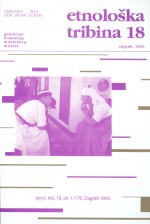Mala sakralna arhitektura u Slavoniji
Small Sacral Architecture in Slavonia
Author(s): Žarko ŠpaničekContributor(s): Stjepan Grgić (Translator)
Subject(s): Christian Theology and Religion, Architecture, Recent History (1900 till today), Cultural Anthropology / Ethnology, 17th Century, 18th Century, 19th Century
Published by: Hrvatsko etnološko društvo
Keywords: sacral architecture; Slavonia; Christianity; religion and rituals; traditional rural culture;
Summary/Abstract: Small sacral architecture in the region of Slavonia consists of shrines, crosses and crucifixes at public places, calvaries, little facade-chapels as well as of posts with sculptures of saints upon them. These architectural forms appeared at the end of 17th and at the beginning of 18th centuries, immediately after these areas had been liberated from Turks. Shrines and crucifixes were built not only at the ruristically dominated points but in the private yards as well. Harmonizing with the traditional architecture the variety of their forms underlines the characteristic feture of Slavonian villages. Facade-chapels in the walls of the houses actally are nitches decorated with sculptures of chosen saints who are considered to be protectors of the houses and the families living in. Wall-chapels are sometimes built simply as the expression of religiousness or for good luck, or just for ornamental purposes. Not only that they show the entanglement of the profane and the sacral, but up to nowadays they also continue the ancient tradition of devoting a part of a house to sacral purposes. Small sacrall architecture was most frequently built by isolated individuals, or some families or a few united individuals, respectively, so that it is more closely connected with informal than with institutional devoutness. Thus, the dual character of formal and informal religiousnes can be seen in Slavonia as well, on one side being expressed in one’s own initiative in building ' and keeping of small sacral architecture, an on the other in relative independence of the common-people religions and rituals as well as in the more peculiar approach to the religion itself. The dose entanglement of profane and small sacral architecture and common-people religion in Slavonia points to the integral character of traditional rural culture.
Journal: Etnološka tribina : Godišnjak Hrvatskog etnološkog društva
- Issue Year: 25/1995
- Issue No: 18
- Page Range: 9-46
- Page Count: 38
- Language: Croatian

